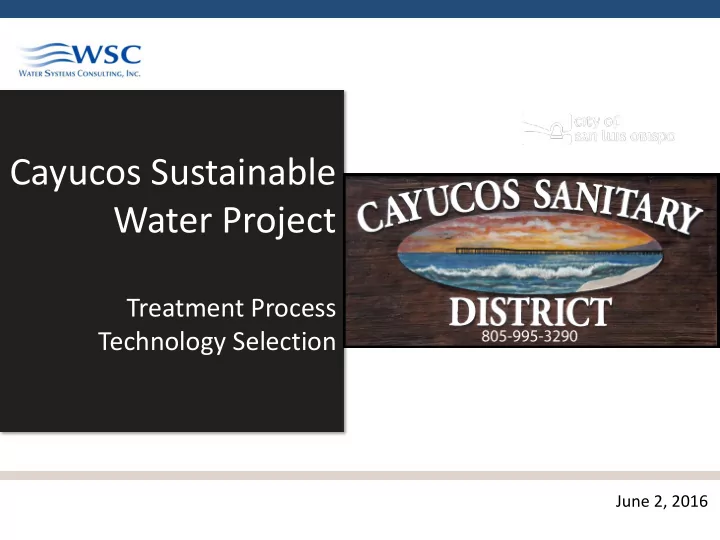

Cayucos Sustainable Water Project Treatment Process Technology Selection June 2, 2016
2 Presentation Overview • Treatment Objectives • Treatment Process Alternatives Recap • Evaluation Criteria • Cost Evaluation Assumptions • Treatment Technology Screening Evaluation
3 Wastewater Treatment Process Overview Unrestricted Irrigation Potable Reuse
4 Treatment Process Objectives Select a process technology that is… • Proven and dependable • Robust and minimizes compliance risk • Capable of providing potable reuse opportunities • Cost effective and maximizes value for ratepayers’ investment • Sustainable for future regulations and population growth • Energy efficient
5 Nutrient Removal Treatment Process Alternatives City of Soledad, CA Alternative 1 Conventional Activated Sludge (CAS) Alternative 2 Los Osos, CA Oxidation Ditch Alternative 3 City of Fillmore, CA Membrane Bioreactor (MBR)
6 Nutrient Removal City of Soledad, CA Alternative 1 - CAS + Advantages • Several non-proprietary configurations • Many operational variants • Technology is well understood - Disadvantages • Large process footprint • Susceptible to process upsets due to load and flow variations
7 Nutrient Removal Alternative 2 – Ox Ditch BBARWA, Big Bear, CA + Advantages • Established technology • Resilient under flow and load variations • Low biosolids production - Disadvantages • Large process footprint • Plant capacity expansion can be difficult • Some modifications are proprietary
8 Nutrient Removal Alternative 3 - MBR + Advantages • Compact footprint suitable for expansion • Combines biological treatment and membrane filtration to enable effective disinfection • Effluent quality provides great potable reuse potential - Disadvantages • Membrane replacement relatively expensive • Requires equalization or additional units to handle peak flow events • Membranes need regular cleaning
9 Evaluation Criteria Economic Criteria • Life cycle cost Non-Economic Criteria • Adaptability for Potable Reuse • Peak Loading Resiliency • Peak Flow Resiliency • Maintenance Requirements • Chemical Needs • Odor Potential • Process Footprint • GHG Emissions/Energy Efficiency • Water Quality Reliability • Adaptability to Phase Tertiary Treatment
10 Cost Evaluation Assumptions • Apples to apples treatment technology cost comparison: Process Alternative 1 Alternative 2 Alternative 3 CAS Ox-Ditch MBR Include Headworks PC Fine Screening Equalization processes that BNR BNR BNR BNR differentiate SC SC MF/UF treatment Filtration MF/UF MF/UF alternatives Solids Thickening / Thickening / Treatment Stabilization Stabilization PC = Primary Clarification BNR = Biological Nutrient Removal SC = Secondary Clarification MF/UF = Microfiltration/Ultrafiltration
11 Cost Evaluation Assumptions Exclude Common Influent pumping Elements Course screening Grit Removal Disinfection Advanced Treatment Solids Dewatering
12 Cost Evaluation Assumptions • Capital costs – 20% Contingency – 30% Indirect costs • O&M costs included for primary, secondary, filtration, and solids handling • Annualize costs over 30 years at 2% interest
13 Treatment Technology Screening Evaluation Normalize Annualized Life Cycle Cost Score qualitative criteria (3= highest score, 2= mid-score, 1= lowest score) Establish importance/weighting factors for qualitative and economic scores (Based on District’s priorities and Project Charter) Sum weighted scores and rank highest to lowest score
14 Non-Economic Criteria Scoring Alternatives CRITERIA Alternative 1 – Alternative 2 – Alternative CAS Ox Ditch 3 - MBR Adaptability for Potable Reuse 3 3 3 Peak Loading Resiliency 2 3 3 Peak Flow Resiliency 2 2 1 Maintenance Requirements 2 3 1 Chemical Needs 2 2 2 Odor Mitigation 1 2 3 Process Footprint 1 1 3 Energy Requirements 2 2 2 Water Quality Reliability 2 2 3 Ability to Phase Tertiary Treatment 3 3 1
15 Treatment Technology Screening Evaluation Criteria Ranking Importance/ Weighting CRITERIA Ranking Total Annualized Cost 1 Adaptability for Potable Reuse 2 Peak Loading Resiliency 2 Peak Flow Resiliency 2 Water Quality Reliability 2 Maintenance Requirements 6 Odor Mitigation 6 Energy Requirements 8 Process Footprint 9 Chemical Needs 10 Ability to Phase Tertiary Treatment 11
16 Treatment Technology Screening Evaluation Alternatives Scoring ALTERNATIVES (SCORING) CRITERIA Alternative 1 Alternative 2 Alternative 3 CAS Ox- Ditch MBR Total Annualized Cost 0.14 0.15 0.14 Adaptability for Potable Reuse 0.14 0.14 0.14 Peak Loading Resiliency 0.09 0.14 0.14 Peak Flow Resiliency 0.09 0.09 0.05 Water Quality Reliability 0.09 0.09 0.14 Maintenance Requirements 0.05 0.08 0.03 Odor Mitigation 0.03 0.05 0.08 Energy Requirements 0.04 0.04 0.04 Process Footprint 0.01 0.01 0.04 Chemical Needs 0.02 0.02 0.02 Ability to Phase Tertiary Treatment 0.01 0.01 0.00 Total Score 0.72 0.82 0.81
17 Treatment Technology Screening Evaluation Alternatives Scoring ALTERNATIVES (SCORING) CRITERIA Alternative 1 Alternative 2 Alternative 3 CAS Ox- Ditch MBR Total Annualized Cost 0.14 0.15 0.14 Adaptability for Potable Reuse 0.14 0.14 0.14 Peak Loading Resiliency 0.09 0.14 0.14 Peak Flow Resiliency 0.09 0.09 0.05 Water Quality Reliability 0.09 0.09 0.14 Maintenance Requirements 0.05 0.08 0.05 Odor Mitigation 0.03 0.05 0.08 Energy Requirements 0.04 0.04 0.04 Process Footprint 0.01 0.01 0.04 Chemical Needs 0.02 0.02 0.02 Ability to Phase Tertiary Treatment 0.01 0.01 0.00 Total Score 0.72 0.82 0.83
18 Key Findings • Oxidation Ditch – Slightly lower cost – Peak flow and loading resiliency – Option to by-pass filtration process during peak flows – Ability to phase tertiary treatment • MBR – High water quality reliability – Small footprint – Better odor mitigation options
19 Recommendation • Receive feedback from the BOD on priorities and preferences • Select a preferred treatment process alternative
20 Next Steps • Refine preferred treatment alternative – Process sizing – Footprint requirements – Solids handling study – Supporting facilities needs assessment • Conceptual Site Plan • Facilities Plan
Recommend
More recommend